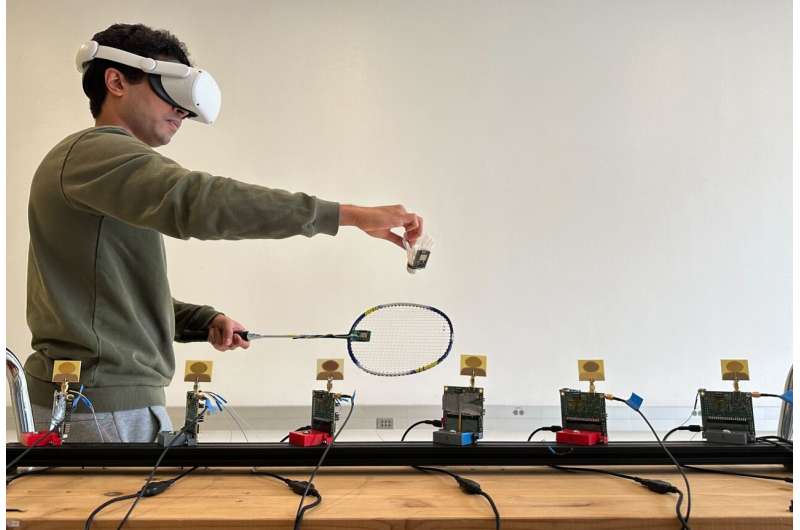This article has been reviewed according to Science X's editorial process and policies. Editors have highlighted the following attributes while ensuring the content's credibility:
fact-checked
preprint
trusted source
proofread
Wireless tracking system could help improve the extended reality experience

A new technology developed by engineers at the University of California San Diego has the potential to make the extended reality (XR) experience smoother and more seamless. The technology consists of an asset localization system that uses wireless signals to track physical objects with centimeter-level accuracy in real-time, and then generates a virtual representation of these objects. Applications of this technology range from enhancing virtual gaming experiences to improving workplace safety.
The team, led by Dinesh Bharadia, a professor in the Department of Electrical and Computer Engineering at the UC San Diego Jacobs School of Engineering, presented the technology at the ACM Conference on Embedded Networked Sensor Systems (SenSys 2023) held in Istanbul, Turkey. The paper is also published on the arXiv preprint server.
Existing localization methods encounter significant limitations. For example, many XR applications use cameras to localize objects, whether it be through virtual reality (VR) devices, augmented reality (AR) glasses, or smartphone cameras, said study co-first author Aditya Arun, who is an electrical and computer engineering Ph.D. student in Bharadia's lab.
"However, these camera-based methods are unreliable in highly dynamic scenarios with visual obstructions, rapidly changing environments, or poor lighting conditions," said Arun. Meanwhile, wireless technologies such as WiFi and Bluetooth Low Energy (BLE) often fall short of providing the required accuracy, and ultrawide-band (UWB) technology involves complex setup and configuration.
The new asset localization system developed by Bharadia's team at UC San Diego, in collaboration with Shunsuke Saruwatari at Osaka University, Japan, overcomes these limitations by providing accurate, real-time localization of objects with centimeter-level accuracy, even in dynamic and poorly lit environments.
The system is also packaged in an easily deployable and compact module, measuring one meter in size, that could be incorporated into electronic devices like televisions or sound bars with minimal setup.
The researchers built their system by harnessing the power of wireless signals in the sub-6 GHz regime. "Unlike camera-based methods, these wireless signals are less affected by visual blockages and continue to operate even in non-line-of-sight conditions," said Arun.
The system uses wireless signals to pinpoint battery-operated UWB tags that are attached to objects. It consists of two main components. One is a UWB tag that transmits a beacon signal for localization.
The other component is a localization module equipped with six UWB receivers that are time and phase-synchronized to receive the beacon signal. As this signal travels, it reaches each receiver at a slightly different phase and time. The system combines these differences in a clever way to accurately measure the tag's location in 2D space.
In tests, the researchers used their system to play a life-size chess game using everyday objects. They retrofitted mugs with off-the-shelf UWB tags, transforming them into virtual chess pieces. As the pieces were moved around on a table, the system was able to smoothly track their movements in real-time with centimeter-level accuracy.
"We found that our system achieves 90th percentile accuracy in dynamic scenarios and performs at least eight times better than state-of-the-art localization systems," said Arun.
The team is currently refining the system. The next steps include improving the PCB design to make the system more robust, reducing the number of receivers to improve energy efficiency, and adding antennas along the vertical axis to support full 3D localization.
More information: Aditya Arun et al, XRLoc: Accurate UWB Localization to Realize XR Deployments, arXiv (2023). DOI: 10.48550/arxiv.2307.12512


















